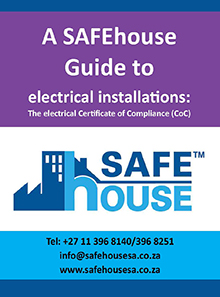FREE DOWNLOADS: HANDY POCKET-SIZED GUIDES ESPECIALLY FOR THE ELECTRICAL INDUSTRY
The SAFEhouse Association’s series of pocket-sized user-friendly guides has been produced especially for the South African electrical industry. These handy guides have been compiled with electrical contractors and installers in mind and provide essential technical information, relevant regulatory information as well as purchasing guidelines in an easy-to-read format.
Pierre Nothard of the SAFEhouse Association, says the prevalence of sub-standard electrical products in South Africa is partly due to misinformation and a lack of information. To address these everyday issues, SAFEhouse has compiled this ongoing series of guides that are authored by industry specialists, to provide pertinent information to promote compliance and electrical safety.
The guides are all available to download at no cost on the SAFEhouse website http://www.safehousesa.co.za/ and hard copy brochures are available in limited quantities, on request, and from the ECA(SA) head office.
 SAFEhouse Guide to Electric Cables
SAFEhouse Guide to Electric Cables
This guide describes the components of electric cables: conductors, insulation, bedding, armouring, outer sheath and markings. It covers voltage rating, current rating, short circuit rating, and earth fault rating. It also lists the compulsory specifications for South African electric cable and gives details of locally manufactured low voltage, medium voltage and high voltage cables. The guides provide examples of substandard cables being sold in South Africa along with advice on what to look for when buying cable.
 SAFEhouse Guide to Surge Protection
SAFEhouse Guide to Surge Protection
This guide to Type III surge protection for SANS 164 products provides information on surges, transients and impulses and what causes them and is illustrated with simple drawings. The applicable standards for surge protected products are listed along with details of the required markings that should be shown on surge protected products. This illustrated guide also explains why a thermal disconnector is crucial and what users should look out for to ensure compliance.
Users have an endless choice of luminaires (light fittings) and this guide goes into basic lighting concepts, luminaire categories and luminaire performance as well as the retrofit of existing installations. Luminaire safety includes marking, insulation classification, construction, components, internal and external wiring, provision for earthing, protection against electric shock and thermal control. This guide also looks at who polices the lighting industry in South Africa, discusses locally manufactured luminaires and gives examples of substandard luminaires being sold in South Africa. The compulsory specifications for luminaires and lighting products are also provided.
 SAFEhouse Guide to LED Lighting
SAFEhouse Guide to LED Lighting
With the rapid changes from traditional lamp types to more efficient LED lighting there is a need for a guide such as this that covers product design basics, and basic lighting concepts, including life expectancy, electromagnetic interference, lamp dimming and colour characteristics. The list of compulsory standards/specifications for LED luminaires covers the standards for LED lamps and control gear. Luminaire safety and LED lamp safety are discussed and information is provided that explains who polices the lighting industry in South African and what to look out for when buying LED products.
 SAFEhouse Guide to Miniature Circuit Breakers – Part 1
SAFEhouse Guide to Miniature Circuit Breakers – Part 1
This illustrated guide explains what a miniature circuit breaker (MCB) does, what it consists of and how it works. It describes the typical internal construction of a thermal magnetic type MCB and gives an overview of the two technologies: thermal magnetic and hydraulic magnetic; what makes them work and why. The MCBs electrical characteristics – voltage rating, current rating, overload characteristics and breaking capacity – are described along with time delay curves and breaking capacity. Information that covers the required marking and information on MCBs is given along with a list of the applicable standards for MCBs.
 SAFEhouse Guide to the Regulation of Electrical Products in South Africa This essential guide outlines the roles of the SABS and the National Regulator for Compulsory Specifications (NRCS) and gives step-by-step instructions on how to apply to the NRCS for Letters of Approval (LOAs), Regulatory Certificates of Compliance (RCCs) and sales permit (SP) and test report requirements. In this guide, you will find lists products that are regulated in terms of compulsory specifications and a wealth of regulatory information and test report requirements. A comprehensive VC Specification table lists the VC specifications, date issued, the products, applicable standards and states whether a RCC or LOA is required. In addition, the guide sets out governing legislation for electrical products and installations.
SAFEhouse Guide to the Regulation of Electrical Products in South Africa This essential guide outlines the roles of the SABS and the National Regulator for Compulsory Specifications (NRCS) and gives step-by-step instructions on how to apply to the NRCS for Letters of Approval (LOAs), Regulatory Certificates of Compliance (RCCs) and sales permit (SP) and test report requirements. In this guide, you will find lists products that are regulated in terms of compulsory specifications and a wealth of regulatory information and test report requirements. A comprehensive VC Specification table lists the VC specifications, date issued, the products, applicable standards and states whether a RCC or LOA is required. In addition, the guide sets out governing legislation for electrical products and installations.
 A SAFEhouse Guide to Electrical Installations
A SAFEhouse Guide to Electrical Installations
This guide is designed to assist end-users as well as electrical contractors. It explains the content of the electrical Certificate of Compliance (CoC) which, if completed with integrity, should serve as the primary assurance of compliance of an installation with safety regulations. The guide also helps users to ask the right questions of their installer. For installers, this guide provides step-by-step instructions on how to complete the CoC correctly in line with the requirements of the Occupational Health and Safety Act and SANS 10142-1 – the national code of practice for the wiring of premises – known as the wiring code.
More info: barry.oleary@safehousesa.co.za











